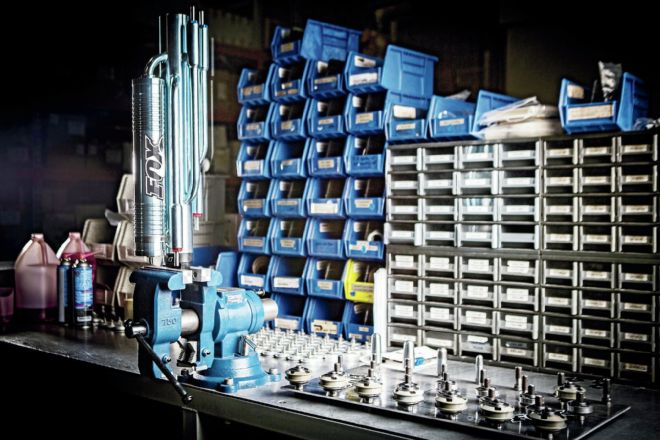
Some of the hardest working parts on your off-road vehicle are the shock absorbers bolted up to the suspension. They soak up hundreds to thousands of bumps on any given day so your chassis and teeth don’t have to. They also help keep the wheels planted on the dirt, giving your ride traction and control when racing across a desolate desert or full-blown race. Some shocks may even double as landing gear when getting airborne and coming back to earth—just ask any gravity-defying pilot at Huckfest or racer who has launched at the Laughlin Leap.
To help keep your off-road shocks working as hard as you drive, it’s important to service them on a regular basis. Maintenance schedules vary by type of vehicle and use (race, prerunner, chase, play), but rule of thumb is at least once a season, in some cases after every race. We have a few more maintenance guidelines below. The important thing to realize is that tired shocks will not perform well and may even become a hazard if damaged or neglected. Just like any other mechanical part on your off-road vehicle, shocks wear and need to be serviced and inspected regularly. This applies to all variations including smooth body, reservoir, piggyback, coilover, and bypass shocks.
The good news is that most rebuildable off-road shocks can be serviced with ease using a few simple tools found in your very own garage. They can also be sent to the factory for professional service—usually with a quick turnaround. To better understand what goes into shock service and maintenance, we enlisted the help of leading off-road shock manufacturers Bilstein, FOX, King, and Sway-A-Way.
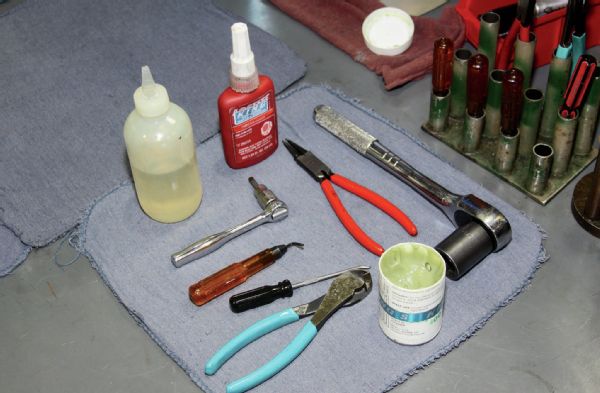 Off-road racing shocks have been designed to be easily serviced with simple tools in the field or at the shop. Some specialty tools like retaining ring pliers and picks will make the job easier. Additional shock specific tools like cylinder and shaft clamps will also help while working on the bench vise. Assembly lube and oil are used on new seals and O-rings so they slide easier and aren’t damaged during reassembly. Loctite is also used on key hardware, like the piston retaining nut, so everything stays tight and doesn’t come loose with vibration.
Off-road racing shocks have been designed to be easily serviced with simple tools in the field or at the shop. Some specialty tools like retaining ring pliers and picks will make the job easier. Additional shock specific tools like cylinder and shaft clamps will also help while working on the bench vise. Assembly lube and oil are used on new seals and O-rings so they slide easier and aren’t damaged during reassembly. Loctite is also used on key hardware, like the piston retaining nut, so everything stays tight and doesn’t come loose with vibration.
Servicing Your Shocks
There are a number of reasons for servicing an off-road shock. Some include maintenance after a race or prerunning, loss of oil, notable decrease in damping or damage. Shock absorbers, especially off-road racing models, have a number of working parts and seals that need to be maintained in order to keep them performing at optimal levels. Shock oil, seals, and wear bands are the most common items replaced during shock rebuilds.
Bilstein recommends their off-road racing shocks be inspected and serviced after every race if running in excess of 250 degrees F. At cooler temperatures, they should be good all season. For recreational users, the shocks may only need to be rebuilt if visible damage or oil leak is present. Shock pressure should also be checked at least once a year to see if there are any leaking seals. When servicing shocks, Bilstein replaces all seals and oil. They even dyno test their shocks to make sure they are operating at spec.
FOX recommends regular maintenance such as checking nitrogen pressure, settings, bushings/Heims/reducers, and cleaning the shock bodies and shaft base every 500 miles for off-road applications. Split street/off-road use vehicles every 1,000 miles, and street only every 10,000 miles. A complete shock rebuild is recommended every 1,000 miles for off-road race applications. Split street/off-road–use vehicles every 10,000 miles, and street every 50,000 miles. A FOX complete shock rebuild service includes new seal kit, new proprietary JM92 Suspension Fluid, deburr and polishing of shock shafts.
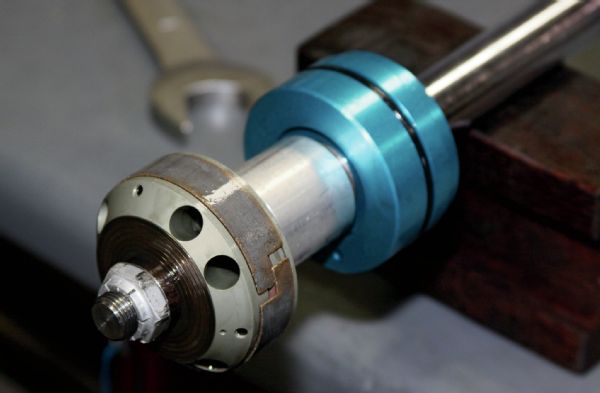 The piston wear band sees a great deal of action as it glides up and down inside the shock body. Race quality wear bands feature resilient material coatings like Teflon to limit friction under extreme use. They do such a great job that when the shock is disassembled, many times they still look like they could go another round. Even if that’s the case, it’s still recommended the wear band be replaced to ensure better performance. There are two wear bands in each shock, one on the main piston and the other on the dividing (Caution: Off-road shocks are under high pressure; make sure to release nitrogen before disassembly).
The piston wear band sees a great deal of action as it glides up and down inside the shock body. Race quality wear bands feature resilient material coatings like Teflon to limit friction under extreme use. They do such a great job that when the shock is disassembled, many times they still look like they could go another round. Even if that’s the case, it’s still recommended the wear band be replaced to ensure better performance. There are two wear bands in each shock, one on the main piston and the other on the dividing (Caution: Off-road shocks are under high pressure; make sure to release nitrogen before disassembly).
King Off-Road Racing Shocks says service intervals for their shocks depend on the use. Race cars get rebuilt after every race or two, play cars every other year. Street vehicles can go for years. It all depends on how hot the shocks get on a regular basis. King service procedures include taking the shock apart, inspecting for wear, cleaning, precision honing and polishing shock cylinder, micro polishing shaft, and replacing all the seals and O-rings using original replacement parts. Fresh, high-quality King shock oil is added before final assembly. Every King Off-Road Racing Shock is pressure tested to verify proper sealing before it leaves their hands.
Sway-A-Way recommends their shocks be serviced once a race season under normal wear and with proper maintenance. According to Sway-A-Way, their specially formulated Baja Blood synthetic oil, high-temp Viton seals and high-quality manufactured parts allow their race shocks to withstand the most extreme off-road conditions. Under some circumstances, the shocks could need servicing sooner due to lack of maintenance and severe situations. Sway-A-Way offers complete shock rebuild service and parts.
Bilstein, FOX, King, and Sway-A-Way off-road shocks can all be serviced by race teams or privateers. It’s recommended they be sent to the manufacturer in order to get a more thorough inspection and rebuild, especially when used for racing. For those wanting to rebuild their own shocks, service parts and rebuild guides are available. Check with your off-road shock manufacturer for additional information.
So before you let another day go by, get under your off-road vehicle and start inspecting those shocks. Service them and rebuild if necessary. Check out the images in this story to get an overview of what goes into rebuilding an off-road shock. It’s not the end-all, but it should wet your whistle. Your race, prerunner, chase, or play vehicle will thank you for it.
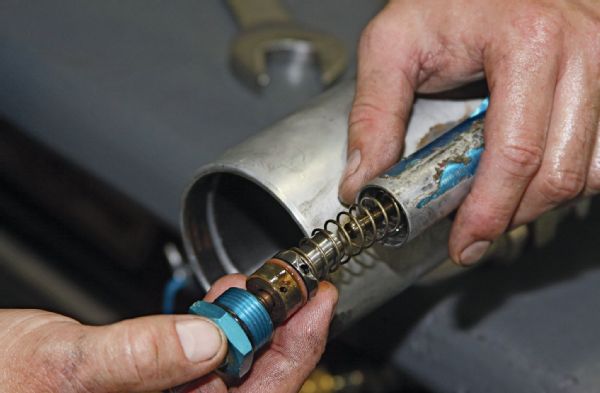
Over time rubber seals deteriorate, especially if high oil temperatures are seen during a race or hearty romp in the dirt. They are fairly inexpensive and should be replaced with new ones during a shock rebuild to assure proper sealing of parts and oil. Even if they look good, don’t reuse them. Seals and O-rings that have been overheated, stretched, or lanced by the pick tool during disassembly are done. You’re better off starting with a fresh set of genuine seals to ensure trouble-free performance and protection.
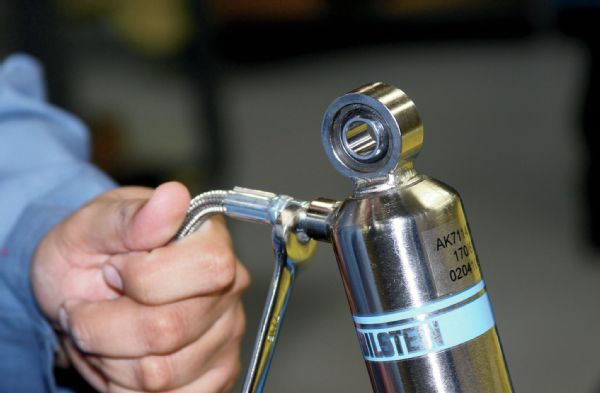
Beyond the internal wear parts, it’s also important to check the remote reservoir hose and spherical bearings for wear or damage. Any visible tear or kink on the hose should be a red flag for potential failure. Clanky spherical bearings should be replaced if showing excessive play, wear, or if they have seized.
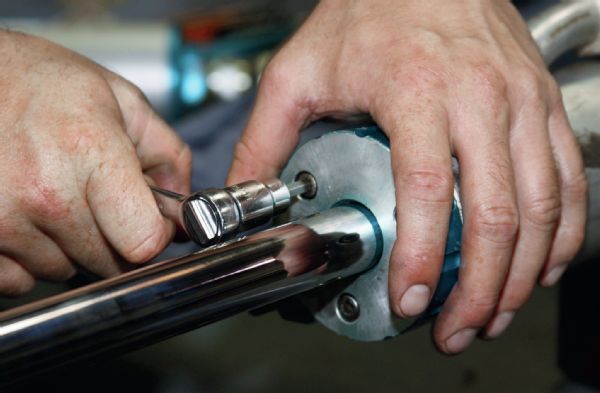
The shock shaft/rod is exposed and often sees its fair share of dirt and rocks. Sometimes the shaft gets nicked and needs to be micropolished to ensure a smooth surface enters the shock and won’t damage seals. Wiper seals found on the base of the shock body can also be damaged by dirt and debris. A damaged seal will result in excessive oil leaking through the shaft and possible oil contamination.
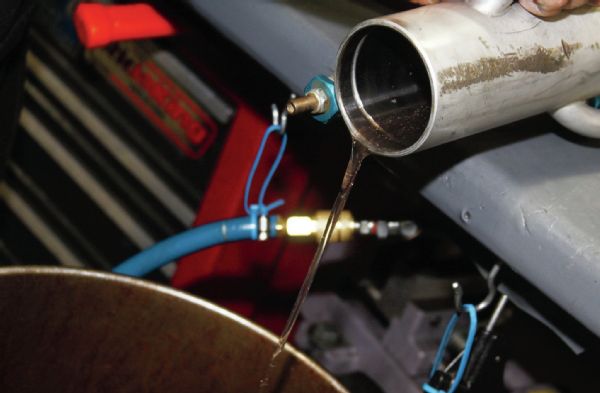
Shock oil is the blood that keeps these hydraulic marvels working. It should be replaced with new fluid when doing a rebuild. Having fresh shock oil will improve shock performance, especially if the old fluid has seen high temperatures and lost its viscosity. Different blends of racing shock oil are available from their respective manufacturer; each specifically formulated to works best with their shock design.
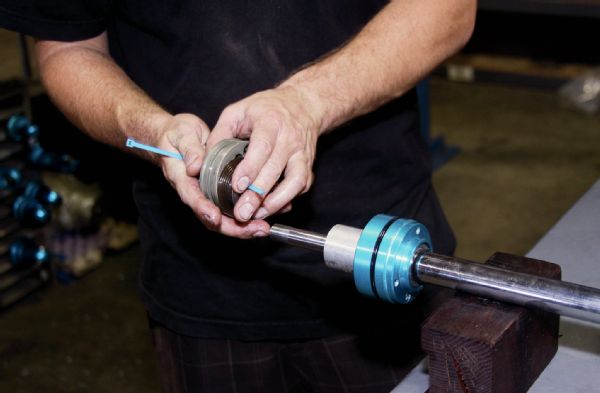
The valve shims found on both sides of the piston are typically not replaced unless they are damaged or the shock is being revalved to get different tuning. It’s important the valving stack and piston stay in the same order. A little trick we picked up from the guys at King Shocks is to simply use a zip tie during disassembly. This will make cleaning and reassembly much easier.
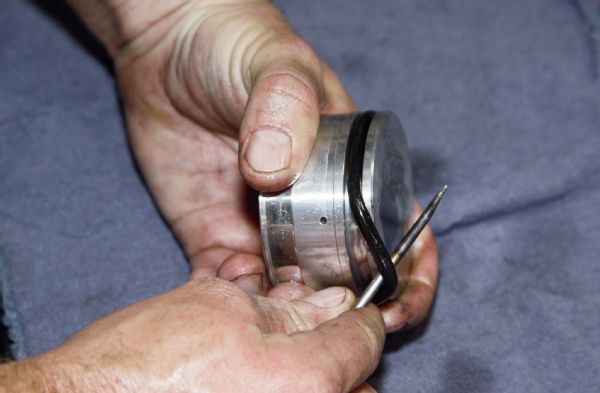
The dividing piston separates oil from nitrogen inside the shock. They are typically found on the reservoir, but can also be in the body if it’s a non-reservoir shock. Nitrogen is used to pressurize the shock so oil can’t form air pockets or cavitate. It’s important the O-ring and wear band be replaced on the dividing piston to ensure good pressure, around 250 to 300 psi.
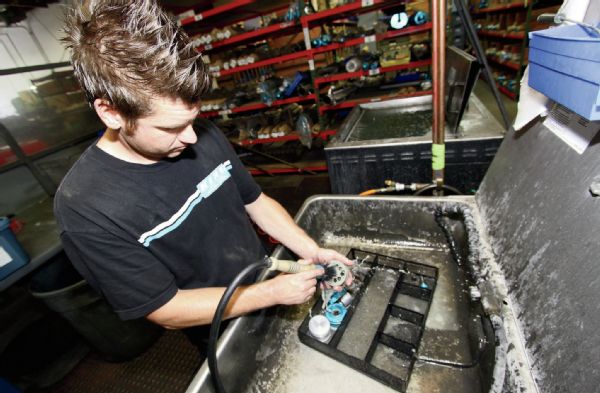
One of the most important parts of servicing your shocks is giving them a good cleaning. Kory Halopoff from King Shocks ran us through their two-step process: Scrub the parts down in hot wash tank, then dunk them in the sonic tank for a deep clean. For you DIYs, simple green and denatured alcohol also works.
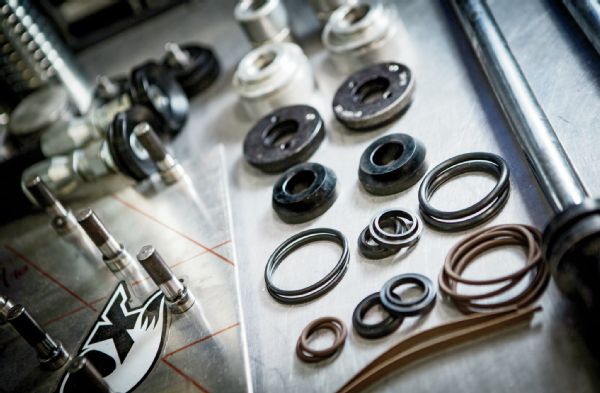
Rebuild kits are brand and shock specific. It’s recommended genuine service parts be used to assure proper fitment and reliability. Service parts, ranging from Schrader valves to rod guides, are available directly from the factory or authorized dealer. A complete parts listing can be found on the manufacturer’s website or catalog.
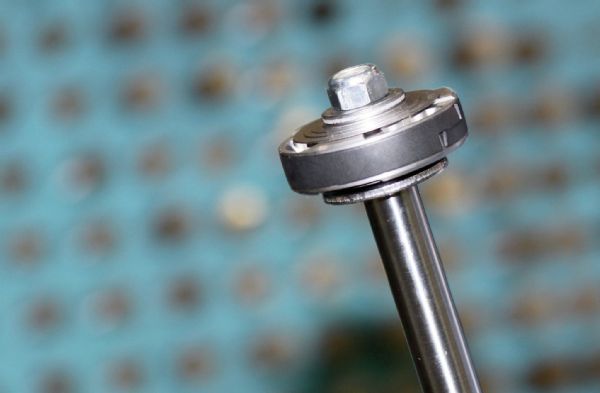
A clean piston and valve shims matched with a new wear band makes its way back into the shock body after parts have been thoroughly cleaned and prepped. Having a vise and rod clamp comes in handy during the reassembly process.
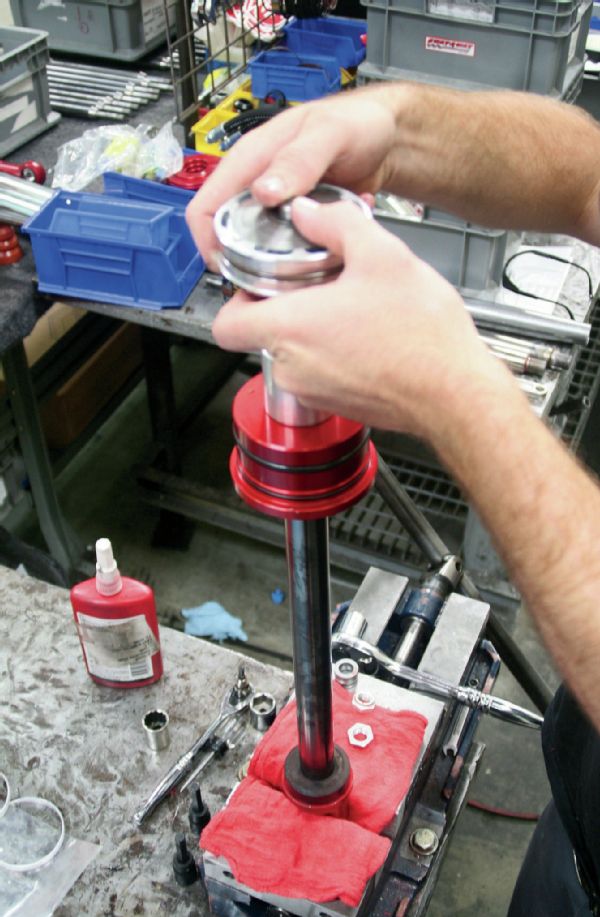
The order of reassembly is important for a successful shock rebuild. Miss a step or forget a part and all that hard work will be wasted. Your vehicle will also ride funny. Although the assembly process is pretty straightforward, it helps to reference a guide. Most off-road shock manufacturers have step-by-step instructions on how to rebuild their shocks—just check their website or give them a call.
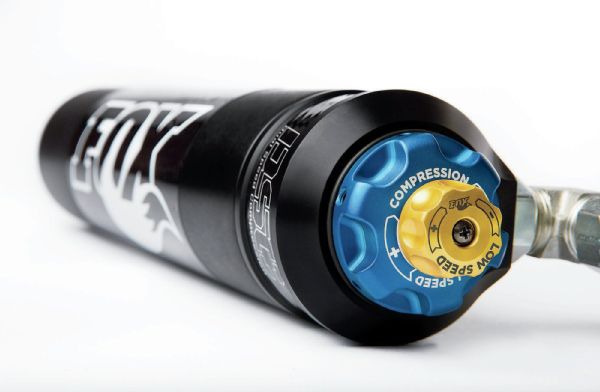
It might be a good time to upgrade components and parts during a rebuild. New piston designs, cooler reservoirs, and compression adjusters are some of the items worth looking into for added performance and driver tunability. Check with your shock manufacturer for complete options.
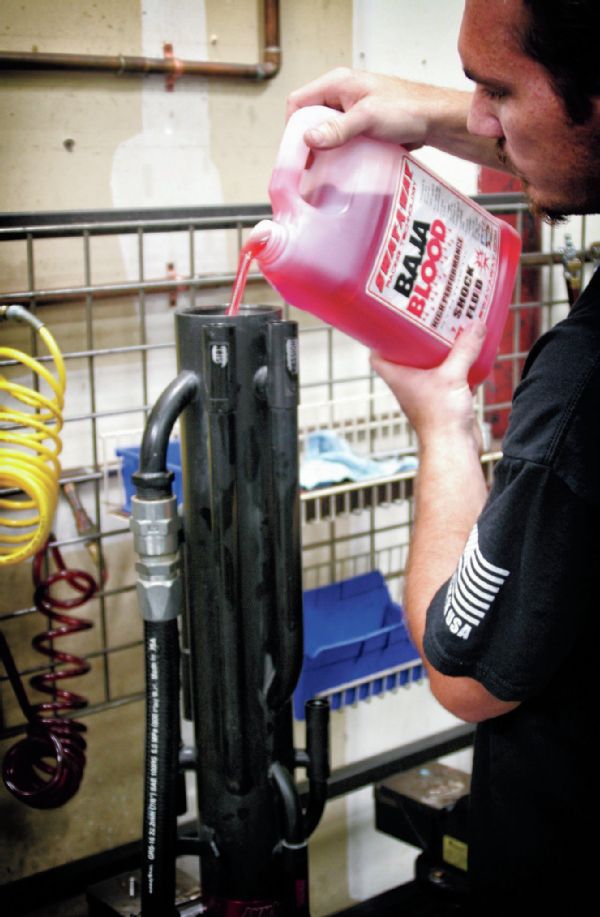
Last but not least, shock oil. Each shock brand has their secret sauce that helps their shocks perform and survive the extreme and bumpy roads that lie ahead. Some companies even have different shock oil for racing applications. Make sure you get the right stuff for your shock. It’s typically sold by the gallon.
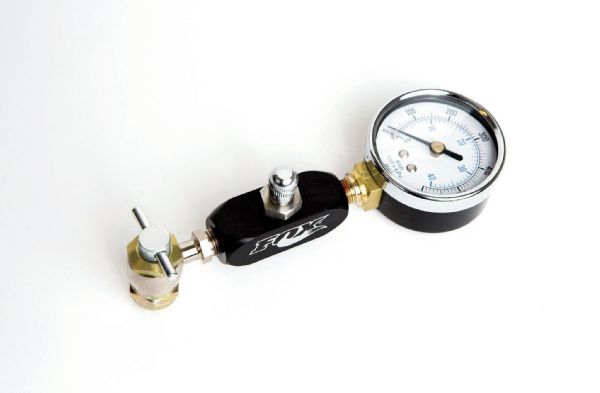
After the shock has been completely reassembled, it’s pressure tested by the tech for leaks. Most off-road racing shocks are shipped back to the customer without nitrogen. You will need a charging manifold and nitrogen tank to fill. Nitrogen gas can be purchased at a welding supply store or off-road race shop.